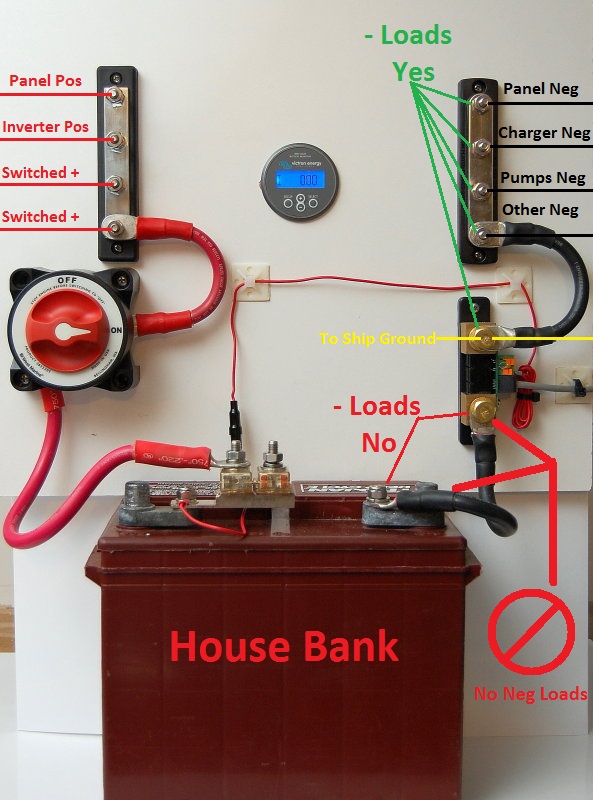I remember being confused about this back when I first set up my battery monitor too.
IF one grounds the house battery directly to the engine battery, then ALL vehicle original battery to frame, battery to firewall, battery to engine grounds must be now moved to engine to shunt, firewall to shunt, frame to shunt, and that is the load/source side of the shunt.
The battery side of the shunt then only has one cable going to each battery individually. This method counts all the current from the alternator into both batteries, not just the house battery. I use this method, as I already had house battery grounded directly to engine battery over a nice 2awg cable, and it is why I like to keep my engine battery as full as possible, so it interferes less with the monitor's ability to accurately count alternator current into the house battery, as a fully charged battery accepts little current, and engine starting does not really consume much at all on a fuel injected engine. I can also use either battery as house or engine battery so this method is necessary in my system.
IF the House battery is grounded to the frame, then one need not move all the original grounds. One then runs a cable from nearby frame to load side of shunt.
Do not attach anything directly to house battery (-) but the single cable from the battery side of the shunt. Buss bars are great, but these 500 amp shunts can accept several terminals stacked as the brass bolts are fairly long and the threads deep. I would not use the bussbar to attach the frame ground, but put it directly on the load/source side of the shunt under the Bussbar cable.
This second method is more accurate, and much simpler, but there is some more resistance added in the circuit, and frame grounds can become problematic with age. Spotlessly clean frame steel and a star washer to dig into both ring terminal and frame is wise. After torquing bolt firmly, cover it with a thicker grease in all the nooks and crannies.
If one( without a battery monitor) is seeking maximum alternator contribution to house battery, it is Best to ground house battery directly to alternator(-) Stud, or an alternator mounting bolt. The Engine battery(-) is the second choice as one is then relying on original engine to battery(-) ground to carry additional current. But the third choice is the frame as one is then relying on not only the original engine to battery(-) but then the frame as well to carry the current, which is a much longer path into which to introduce resistance.
One can negate any performance loss of grounding house battery to frame, by running an additional ground from alternator(-) or mounting bolt to nearby Frame, accounting for engine flex.
Please note that the battery cables sold in autoparts stores are SAE rated, which is about 20% thinner wire than AWG. They also use Steel ring terminals. They slip a tube of steel over the wire and crush it, then drill a hole through steel and copper wire together.
Steel is a poor conductor, and it rusts, and it will develop very high resistance, and get very hot, reducing current flow, and increasing the rate at which the frame ground deteriorates. Proper ring terminals on AWG wire is many fold better than Store bought cables that have steel ring terminals, and the difference increases with age
So the quality of any frame ground you add is very important, and it is so much easier to do it right the first time, then have to redo it later when one notices performance loss.
And with a battery monitor, you now have the tools to measure performance loss.
There is something to be said for the 'ignorance is bliss' mantra that some espouse.
So If all of this confuses you, in your provided picture, simply run a cable from frame to source/load side of the shunt, where it says in yellow, 'ship to ground', and have one cable only going to battery (-) from battery side of the shunt, and nothing else on house battery (-)
If you already have a fat cable from house battery(-) to engine battery(-), then you must remove all original engine battery to frame/engine/firewall and place them on the load side of the shunt. Otherwise the shunt cannot measure all the current going into or out from the house battery as there is another path back to( in reality, from) ground which bypasses the shunt.












































































